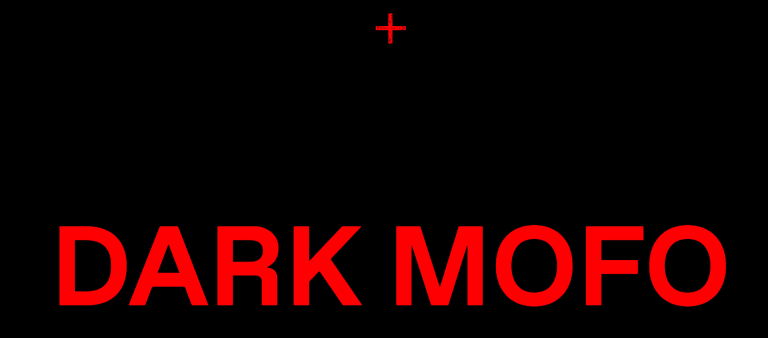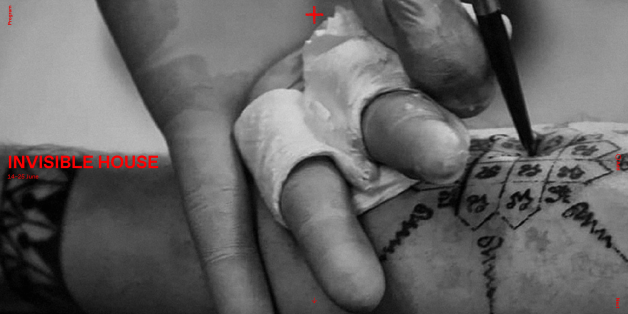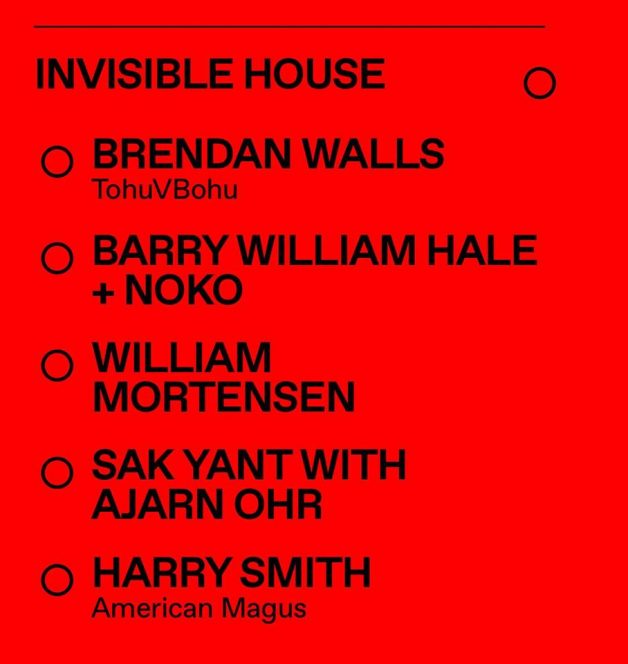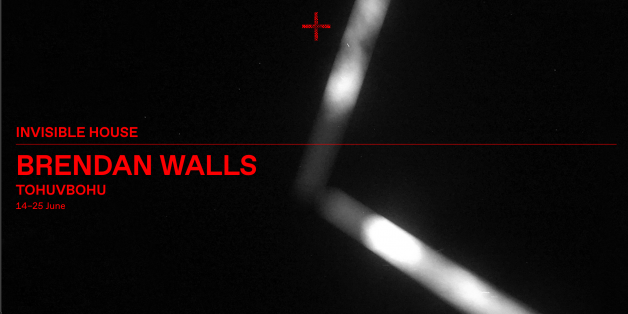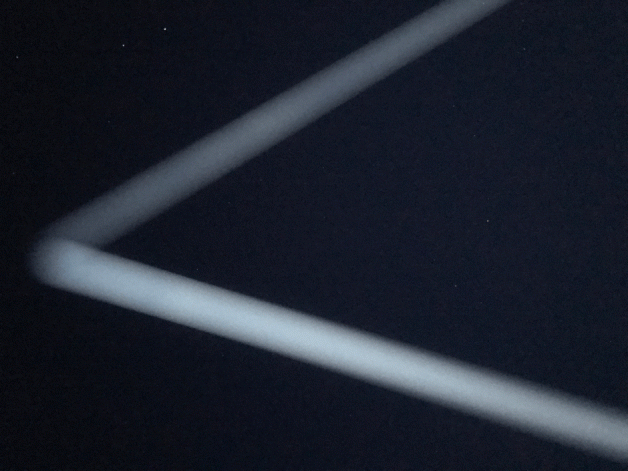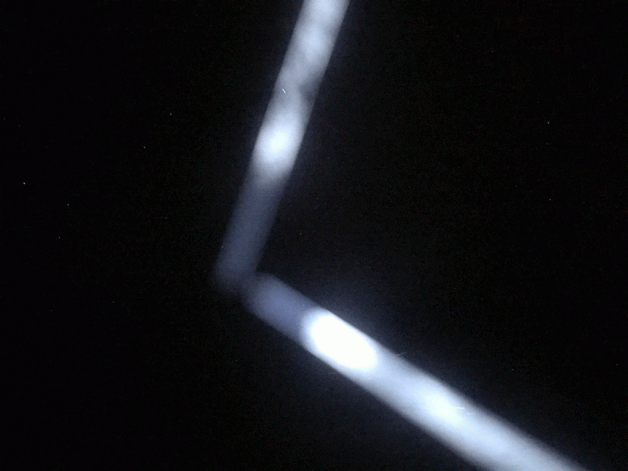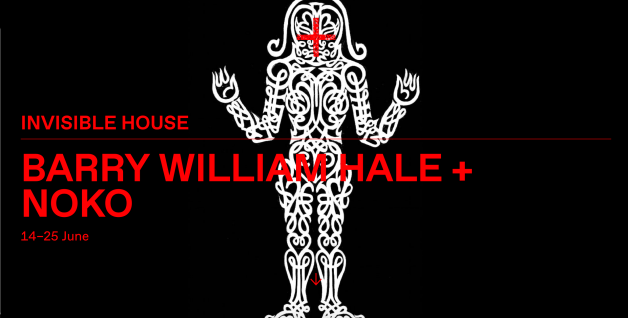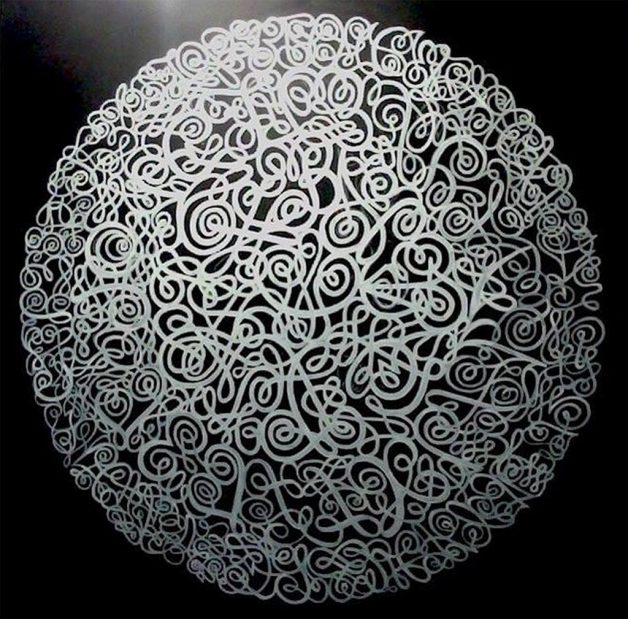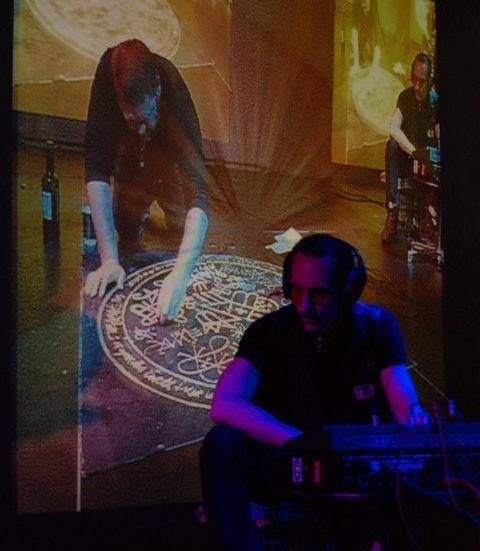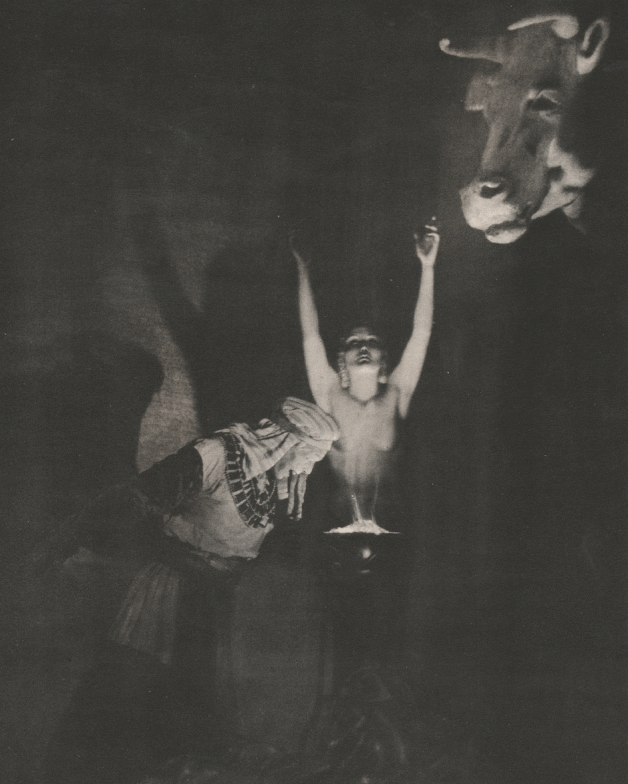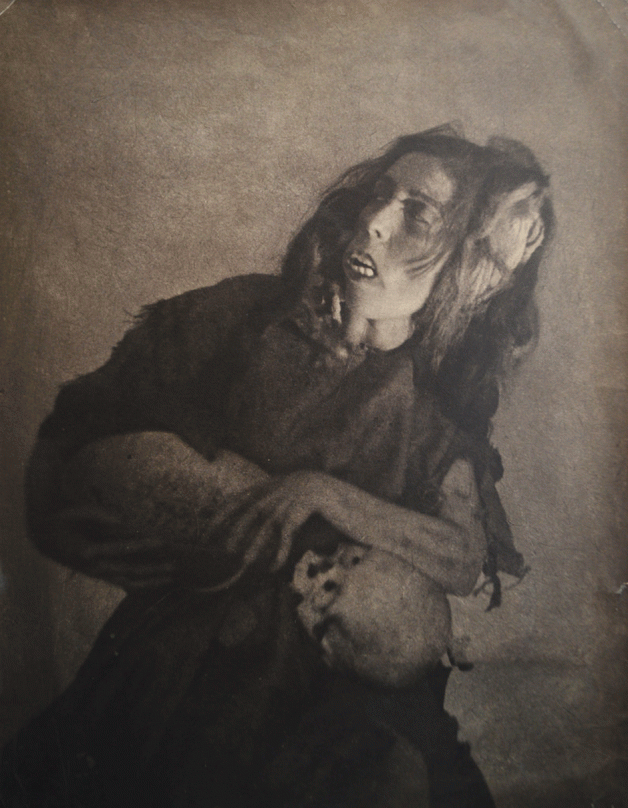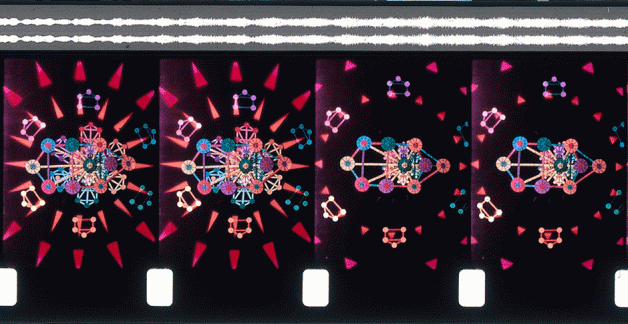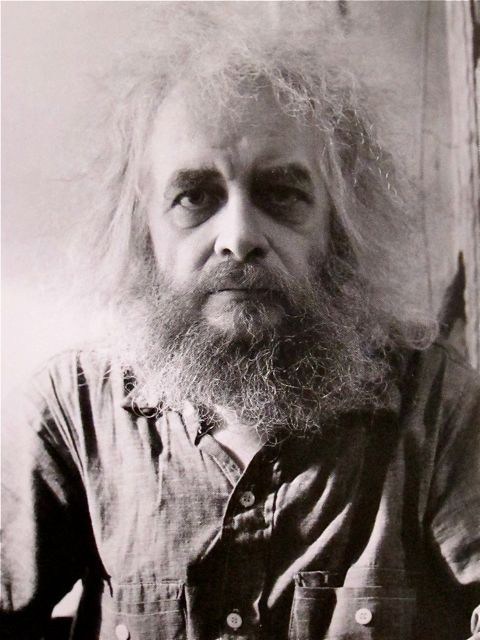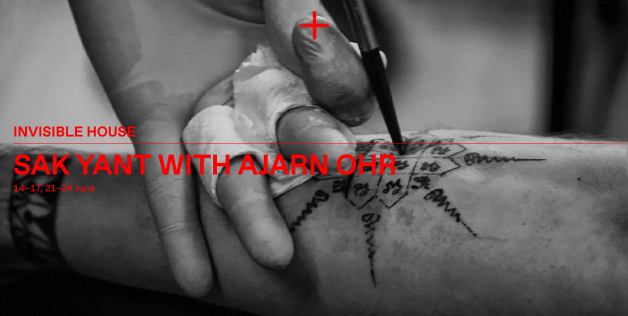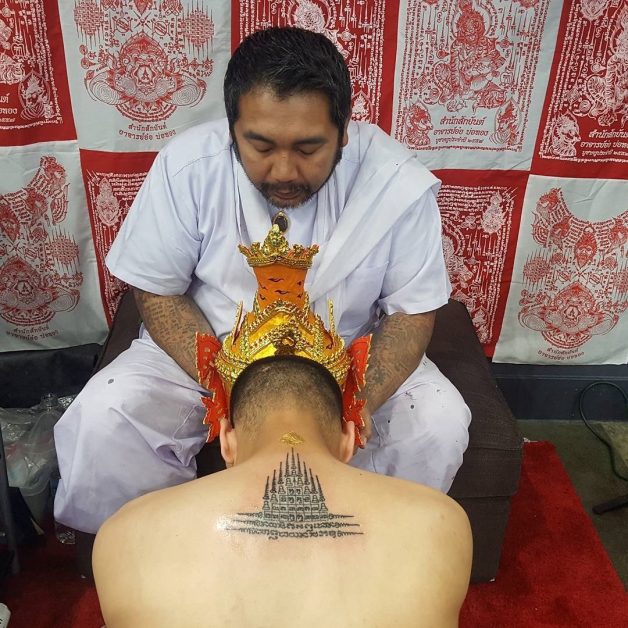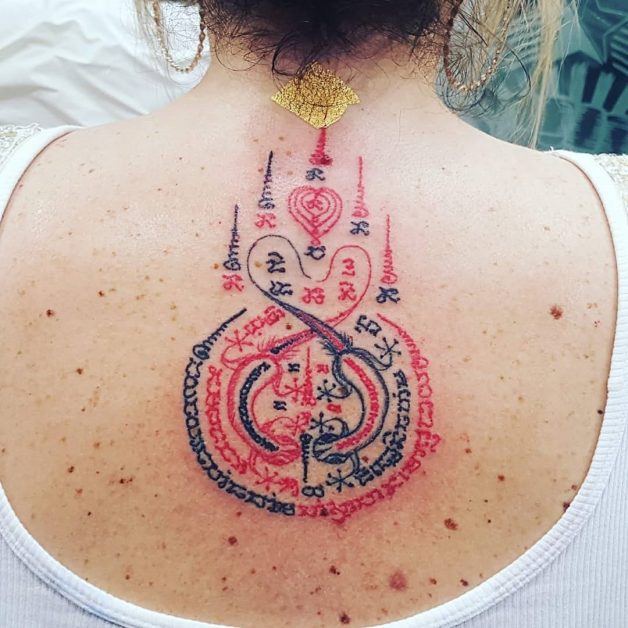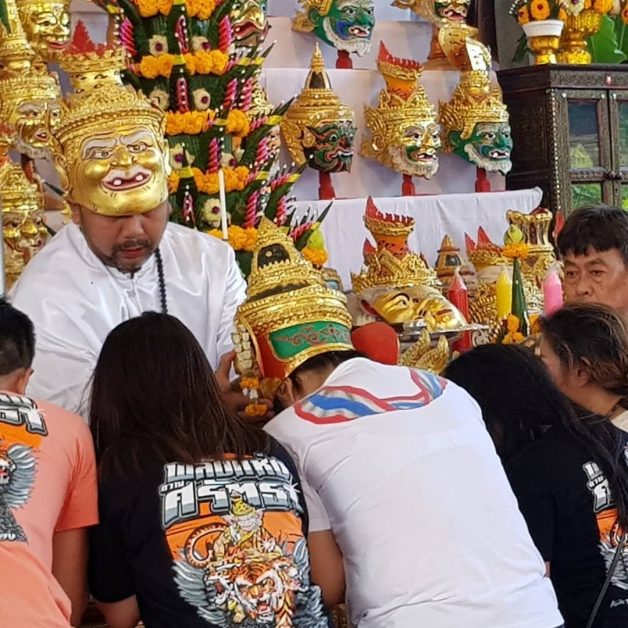“But your holy place shall be untouched throughout the centuries: though with fire and sword it be burnt down & shattered, yet an invisible house there standeth…”
Liber AL vel Legis 3:34
INVISIBLE HOUSE
DARK MOFO 2018
13–24 June 2018, Hobart, Tasmania, Australia
curated by Brendan Walls
Invisible House is a ground-breaking cross media program that seeks to unsettle the barriers between performance, and static arts; science and magic; space and time.
Salamanca Arts Centre (SAC), after consolidating 40 years in 2017, throws open its walls, halls and spaces to maverick filmmakers, visionary photographers, installation artists, automatic painters, and committed ritualists in a celebration of arcane knowledge, the sacred and the numinous.
“The psychotic drowns in the same waters in which the mystic swims with delight”
Joseph Campbell
Invisible House is the sacred wedding of refined rapture and divine madness.
Origin Myth
Invisible House began with the solo work ‘Tohu V Bohu’ by Brendan Walls which explores the nigredo or ‘blackening’ work of alchemy (putrefaction, cleansing, cooking where the base material is rendered uniformly black). The first stage of the transformation of the base material into spiritual gold.
The program has expanded to include works that similarly apply heat, pressure, and time to transform the common place into the transcendent.
Each work tests the limits of physical and psychic endurance of the artist, seeking to break through self-imposed limits, churning the waters of the subconscious, and producing a visceral unedited experience that the straight art world often toys with but never commits to.
“The gross must pass through fire…”
Liber AL vel Legis 1:50
Brendan Walls is an interdisciplinary artist, experimental composer and performer. His work utilises a variety of handmade instruments and sound producing sculptural objects, considering psycho-acoustic properties of performance and gallery spaces, physical and technological limitations, failing systems, collapse, physical testing and transformation of consciousness. With a career spanning more than 20 years Walls has performed extensively in Australia and Overseas. He has released over 20 albums, both solo and in collaboration. In 2002 Walls first solo release Cassia Fistula, produced by Idea Records, U.S.A was featured in Artforum and Wire Magazines. He has been included in international symposiums, publications and Biennales concerning experimental and improvisational practice and debate, showcasing in 21:100:100 – One Hundred Sound Works by One Hundred Artists from the 21st Century (Gertrude Contemporary, Melbourne /Long Gallery, Hobart).
Light, music, sculpture, ritual, sound and performance are brought together to celebrate encounters with the numinous, memory, time, coincidence and the transcendent. The site-specific installation will be regularly transformed by an unfolding series of private and public rituals and performances culminating in a 24-hour performance of a musical score for strings and percussion, formed from recordings made in Mexico and Italy on the feast day of John the Baptist (24th June).
13 years in development, the score final score will be realised by killers from the local experimental music community.
Barry William Hale and Scott Barnes use the Enochian alphabet – the script ‘revealed’ to John Dee and Edward Kelley by angels in the sixteenth century – to conjure esoteric art, live music and an unfolding series of audio-visual artworks. This is a continuation of a decades-long research project of art, occult rituals, magic and psychic phenomena.
Barry William Hale is considered one of the key exponents of esoteric art internationally. Barry is working with long term collaborator Scott Barnes, on their decades long, art/magical/psychic research project NOKO. More than just the performative aspect of Hale’s various lines of esoteric research, this incarnation of HYPRKUB 210 is the culmination of 15 years continuous work and incorporates ritual, live music, invocation and automatic art. Each day the space will house the artistic ‘residue’ of the previous day’s occult operation.
A Tasmanian premiere.
William Mortensen (1897 – 1965) was an American Photographer, primarily known for his Hollywood portraits in the 1920s-1940s in the pictorialist style.
Ansel Adams called him ‘the Antichrist’ and wanted him written out of history. But William Mortensen’s grotesque photographs of death, nudity and torture and are now having their day..
..Mortensen’s methods often made it hard to distinguish whether the results were photographs or not. He used traditional printmaking techniques, such as bromoiling, and developed many of his own techniques. He created composite images, scratch, scrape and draw on his prints, then apply a texture that made them look like etchings, thereby disguising his manipulations. Consequently, every print was unique. Ultimately, Mortensen’s aim was to create something that, for all intents and purposes, appeared to be a photograph, yet portrayed scenes so fantastic they caused wonder and astonishment in the viewer.
Harry Smith was a filmmaker, painter, recording pioneer, American folk music historian, musicologist, and occultist. A complete retrospective of his ground-breaking and wholly unique celluloid invocations. Generously supported by the Harry Smith Archives,
HARRY SMITH (1923-1991)
Harry Smith was an artist whose activities and interests put him at the center of the mid twentieth-century American avant-garde. Although best known as a filmmaker and musicologist, he frequently described himself as a painter, and his varied projects called on his skills as an anthropologist, linguist, and translator. He had a lifelong interest in the occult and esoteric fields of knowledge, leading him to speak of his art in alchemical and cosmological terms.
Harry Smith was born May 29, 1923, in Portland, Oregon, and his early childhood was spent in the Pacific Northwest. Smith’s father, Robert James Smith, was a watchman for the local salmon canning company. His mother, Mary Louise, taught school on the Lummi Indian reservation. Robert Smith’s grandfather had been a prominent Freemason who was a Union General in the Civil War. Harry’s parents were Theosophists, who exposed him to a variety of pantheistic ideas, which persisted in his fascination with unorthodox spirituality and comparative religion and philosophy. By the age of 15, Harry had spent time recording many songs and rituals of the Lummi and Samish peoples and was compiling a dictionary of several Puget Sound dialects. He later became proficient in Kiowa sign-language and Kwakiutl. In addition to developing complicated systems for transcription, he also amassed an important collection of sacred religious objects, one of a number of museological endeavors that occupied Smith throughout his life.
Smith studied anthropology at the University of Washington for five semesters between 1943 and 1944. After a weekend visit to Berkeley, during which he attended a Woody Guthrie concert, met members of San Francisco’s bohemian community of artists and intellectuals, and experimented with marijuana for the first time, Smith decided that the type of intellectual stimulation he was seeking was unavailable in his student life.
It was in San Francisco that Smith began to build a reputation as one of the leading American experimental filmmakers. He showed frequently in the “Art in Cinema” screenings organized by Frank Stauffacher at the San Francisco Museum of Modern Art. Smith not only became close with other avant-garde filmmakers in the Bay Area, such as Jordan Belson and Hy Hirsh, but traveled frequently to Los Angeles to see the films of Oskar Fischinger, Kenneth Anger, and other Southern Californians experimentalists. Smith developed his own methods of animation, using both stop motion collage techniques and, more uniquely, hand-painting directly on film. Often a single film required years of painstakingly precise labour. While a few other filmmakers had employed similar frame-by-frame processes, few matched the complexity of composition, movement, and integration in Smith’s work. Smith’s films have been interpreted as investigations of conscious and unconscious mental processes, while his fusion of colour and sound are acknowledged as precursors of sixties psychedelia. At times, Smith spoke of his films in terms of synaethesia, the search for correspondences between colour and sound and sound and movement.
Smith’s films cannot be easily separated from his paintings, and in both he was influenced by the abstract work of Kandinsky, Marc, and others who formed the foundation of the collection of the Museum of Non-Objective Painting (later the Guggenheim Museum) in New York. Smith developed a relationship with Hilla Rebay, the museum’s director, and she arranged for Smith to come to New York and to receive a Solomon Guggenheim grant in 1950. He moved to New York permanently in the early fifties. In need of money, he offered to sell his extraordinary record collection of American vernacular music to Folkways Records. Instead, Moses Asch, the label’s president, challenged Smith to cull his collection into an anthology.
In 1952 Folkways issued Smith’s multi-volume Anthology of American Folk Music. The Anthology was comprised entirely of recordings issued between 1927 (the year electronic recording made accurate reproduction possible) and 1932, the period between the realization by the major record companies of distinct regional markets and the Depression’s stifling of folk music sales. Released in three volumes of two discs each, the 84 tracks of the anthology are recognized as having been a seminal inspiration for the folk music revival of the 1950s and 1960 (the 1997 reissue by the Smithsonian was embraced with critical acclaim and two Grammy awards). Traditional American music was only one of Smith’s musical interests. From the late 1940s, he was a passionate jazz enthusiast, going so far as to create paintings that are note-by-note transcriptions of particular tunes. He spent much of the fifties in the company of jazz pioneers like Charlie Parker, Dizzy Gillespie, and Thelonious Monk. Smith’s involvement with recording continued into the sixties and seventies as he produced and recorded the first album by the Fugs in 1965. His long-term friendships with many of the Beat writers led to the release of Allen Ginsberg’s First Blues in 1976 as well as unreleased recordings of Gregory Corso’s poetry and Peter Orlovsky’s songs. Smith spent part of this era living with groups of Native Americans, and this resulted in his recording the peyote songs of the Kiowa Indians (Kiowa Peyote Meeting, Folkways, 1973).
Smith’s broad range of interests resulted in a number of collections. He donated the largest known paper airplane collection in the world to the Smithsonian Institution’s National Air and Space Museum. He was a collector of Seminole textiles and Ukrainian Easter Eggs. He also considered himself the world’s leading authority on string figures, having mastered hundreds of forms from around the world.
Smith spent his last years 1988-1991) as “shaman in residence” at Naropa Institute, where he offered a series of lectures, worked on sound projects, and continued collecting and researching. In 1991 he received a Chairman’s Merit Award at the Grammy Awards ceremony for his contribution to American Folk Music. Upon receiving the award, he proclaimed, “I’m glad to say my dreams came true. I saw America changed by music.”
Harry Everett Smith died at the Chelsea Hotel on November 27, 1991.
An absolute first for Australian eyes and skin. One of the world’s most revered Ajarn or Master, Ajarn Ohr, will conduct daily prayer, and ritual tattooing to subscribed festival guests.
Sak Yant masters are known by various respectful names such as Master or Ajarn, sometimes spelled Ajahn. The word Ajarn means teacher or mentor. Some Ajarns do not do sacred Sak Yant tattooing but instead teach Buddhism, meditation, or even do special healing massage.
Some Masters of Sak Yant gained their expertise at a famous temple such as Wat Bang Phra which has long been known for its Sak Yant tattoos. While others may not have been a monk at such a temple, but may have gained their knowledge and sacred skills by apprenticeship to their father or through Abisheka, a sacred Buddhist initiation that passes wisdom and knowledge directly through the lineage of Master to Disciple.
It takes many years of training and study to become a good Sak Yant Master. Sak Yant sacred Thai traditional tattoos have many elements within them, ancient magical knowledge, Buddhism, Animism, ancient symbols and text, and Sacred geometry all intertwined into the creation and blessing of them.
Some tattoo studios offer Sak Yant tattoos done in the studio by a tattoo artist who has been trained in the design of them, but they do not usually offer the blessing by the Master or the infusion of the blessings into the design. Nothing quite compares with the life changing experience of having a real Sak Yant sacred bamboo tattoo done by a really skilled master, who learned those skills over the years from his own father or his Sak Yant Master.
Ajarn Ohr is one of best Sak Yant Thai Bamboo tattooist in the world. He works from a sacred space known as a Sam Nak. Ajarn Ohr has four disciples. This is his first time in Australia.
On the unique experience of Sak Yant for Dark Mofo by his translator Paeng
Bangkok Ink brings the renowned Ajarn Ohr from Thailand to perform the traditional thai “sak yant” tattoos and blessings. The thai word “sak yant” literally translates to magic tattoo. These ancient, spiritual tattoos and rituals are well known throughout south east asia. Their magical properties bring the wearer benefits such as good health and prosperity. Some even believe they can protect the wearer from physical harm! These days many receive these tattoos to help them enjoy more success and overcome difficult times in their lives. Of course many will get them for their beauty and the experience alone.
Usually available only in Thailand, this phenomenon is coming for a short time to the amazing Dark MOFO festival. A chance to see a master at work in an ancient and still relevant practice of spirituality and belief!
DARK MOFO : INVISIBLE HOUSE
full festival site: DARK MOFO
SALAMANCA ARTS CENTRE : http://www.salarts.org.au/portfolio/invisible-house-darkmofo2018/

